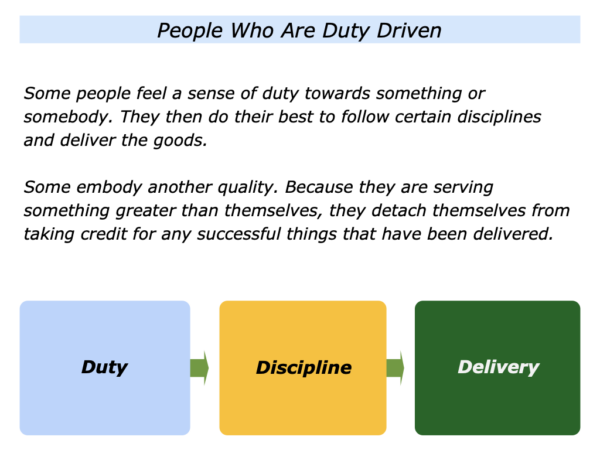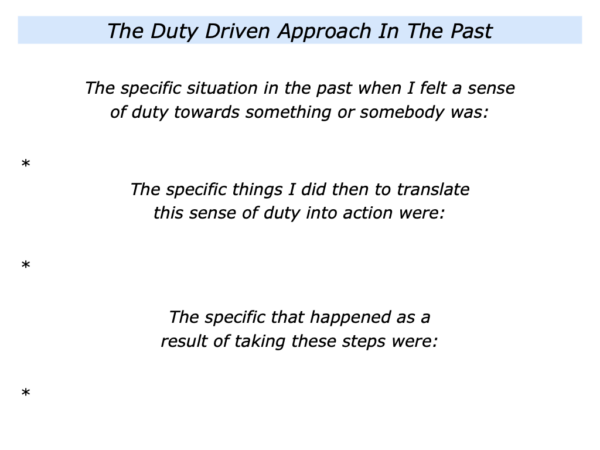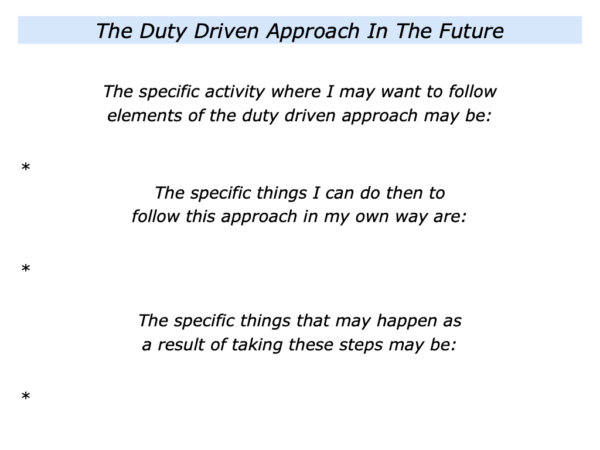
Some people are duty driven. They may feel a sense of duty to care for their loved ones, follow a moral code, pursue a philosophy, follow their vocation or serve something greater than themselves.
Some spiritual faiths describe the concept of dharma. This involves having the duty to follow certain spiritual laws – such as those of right livelihood or other cosmic principles.
Such people often aim to follow their sense of duty. They then do their best to follow certain disciplines – such as principles in their life and work – and deliver the goods.
This approach calls for following certain disciplines, doing your best and aiming to deliver. It also calls for aiming:
To continue to improve the way you follow certain disciplines;
To detach yourself from taking credit for any successful outcomes.
Looking back, can you think of a time when you may have followed some elements of the duty driven approach? This could have been in your personal or professional life.
What was the specific situation when you felt a sense of duty towards something or somebody? What did you do then to translate this sense of duty into action? What happened as a result of taking these steps?
If you wish, try tackling the exercise on this theme. This invites you to complete the following sentences.

Different people follow the duty driven approach in different ways. Whatever route they take, however, this often involves them focusing on the following themes.
Duty
Some people develop a sense of duty early in life. They may learn from their parents, for example, that is it important to follow certain principles in their lives and work.
Some people develop a sense of duty later in life. This may involve choosing to care for their loved ones, follow their own chosen principles or pursue a vocation.
The specific kind of duty that a person chooses to follow can have consequences. Some may follow principles that help them and other people. Some may follow principles that benefit them but hurt other people.
A kind person may have a strong sense of duty, for example, but so may a terrorist. The principles they choose to follow can have different consequences.
Some people feel a duty to their talent. They may then show great discipline as a musician, chef, athlete, mathematician or in another role. They do the right things in the right way to make full use of their gifts.
Some people feel a duty to a mission. They dedicate themselves to raising money for a charity, climbing a mountain, inventing a pioneering product or another activity. They feel fully alive when pursuing this purpose.
Some people feel a duty to a moral code. They may follow their inner compass, pursue a spiritual path or live their values. They aim to translate their beliefs into action in their daily lives.
Miep Gies described how she took this approach in her book Anne Frank Remembered: The Story of the Woman Who Helped to Hide the Frank Family. She described this in the following way.
Helping people who are in danger is not a matter of courage but from making a decision that every human being has to make when he or she distinguishes between good and bad.
Miep was one of a group that helped the Frank family, who hid in an annexe next to the office where she worked as Otto Frank’s secretary. After the family were betrayed she retrieved and safeguarded Anne’s diary.

Imagine that you feel a sense of duty towards something or somebody. This can then involve focusing on the next step taking by people who follow this approach.
Discipline
People who are duty often feel driven do their best to follow certain daily disciplines. But such people need to believe that pursuing this pattern will enable them to fulfil their duty.
Sometimes the discipline may come from the outside. A person may pursue their sense of duty by choosing to join a group such as a spiritual community, profession, police, military or another organisation.
Such an institution often communicates a code of behaviour that people need to follow. People then follow this creed because they see how it will help to fulfil the mission.
Sometimes the discipline comes from within. Creative artists, for example, often follow certain individual rituals that enable them to work each day.
Some people who follow the disciplined approach love to make lists either on paper or in their heads. They then get a kick from crossing off completed items on the way towards achieving their aims.
Such people may experience both pluses and minuses in their approach. The pluses can include pursuing a clear goal, having a sense of meaning and doing satisfying work. The minuses can include appearing robotic, failing to see the big picture or serving a false ideal.
Some people often demonstrate Obsessive Compulsive Discipline rather than Disorder. They follow their regular pattern without thinking. This enables them to keep doing the basics and sometimes add the brilliance.
Imagine that you have a strong sense of duty. You may wish to encourage other people, follow a spiritual faith, make good use of your talent or pursue another activity. When appropriate, you may explore the following themes.
What are the disciplines I want to follow in my daily life or work? What can I actually do – in behaviour terms – to translate these disciplines into action? What will be the pluses and minuses involved when following the disciplines? How can I build on the pluses and manage the minuses?
How can I get a good start to the day by following some of these disciplines? How can I keep doing the right things in the right way? How can I develop a daily rhythm to keep doing these things? How can I encourage myself on the journey?
As mentioned earlier, one approach is to develop a rhythm that you follow each day. Sometimes this calls for getting enough rest, rehearsing what you are going to do next and then clicking into action.
After a while you may follow the rhythm without thinking. It is something you simply do each day on the ways towards achieving certain aims in your life and work.
People who follow their principles are more likely to have a sense of purpose and live in what the existentialist call good faith. This approach can also involves enjoying the journey as well as reaching the goals.
Imagine that you are doing your best to follow certain disciplines. This can sometimes involve focusing on the next step taken by people who follow this approach.
Delivery
People who are duty driven often aim to do their best to deliver the goods. The specific principles they follow, however, will determine the kinds of things that they deliver.
A person who is kind may simply aim to encourage other people. Sometimes this can lift other people and help to create positive memories for life.
A person who wants to help others to have the basic materials for life may do practical things to people who are homeless, hungry or in need of water.
A person who is artistic may aim to create art, songs, films, beauty or other thing. They may want to use their strengths to inspire or move people in some way.
Some people may focus on producing other tangible things. They may am to deliver things that improve people’s quality of life, produce social changes or help to build a certain kind of world.
Some people believe in serving something greater than themselves. They aim to do their best in life but also detach themselves from taking credit for any successful things that have been delivered.
Such people believe that following certain principles produces its own rewards. They also keep focusing on how they can improve the way they serve the thing that is greater than themselves.
There are many ways to live life. Some people choose to follow the duty driven approach. They then do their best to follow certain disciplines and deliver the goods.
Let’s return to your own life and work. Looking ahead, can you think of a specific activity where you want to follow elements of this approach? How can you do this in your own way? What may happen as a result?
If you wish, try tackling the exercise on this theme. This invites you to complete the following sentences.







Leave a Reply